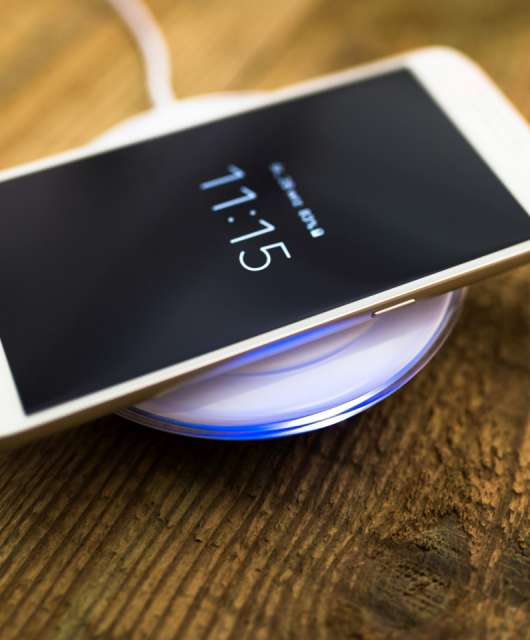Have you ever been watching a YouTube video, searching the web, answering emails and more, all at the same time on the same device? If so, you may have noticed your device becoming hot to the touch or the fan running at increasingly high speeds. This is because the central processing unit (CPU) is overheating.
A number of factors can cause this: dust, a lack of ventilation, malfunctioning parts or even background applications. Most PC users install many programs over time, a lot of which work in the background. Applications like browsers, extensions and games working simultaneously can put a strain on your CPU. If left untreated, high CPU temperatures can damage or destroy devices.
If your computer is overheating, you’ll want to check your CPU temperature and troubleshoot your PC accordingly. We’ll explore how to check CPU temp, why your CPU may be overheating and what you can do to prevent it.
How to Check CPU Temp on Windows 10 and Windows 11
There are two methods to check your CPU temperature: using third-party applications or manually checking your computer’s BIOS.
Outside of manual checks, it’s possible to check CPU temp with apps on both Windows and Mac devices. The Core Temp app is one of the most accessible app options that allows you to monitor the temperature of all your computer’s processors.
The app isn’t complicated and is fairly easy to navigate. After you download and install Core Temp, follow these steps to check your CPU temperature:
Step 1: Open the application.

Step 2: Locate the temperatures of your processors at the bottom of the widget under Temperature Readings. The Max column will show you the highest recorded CPU temps.
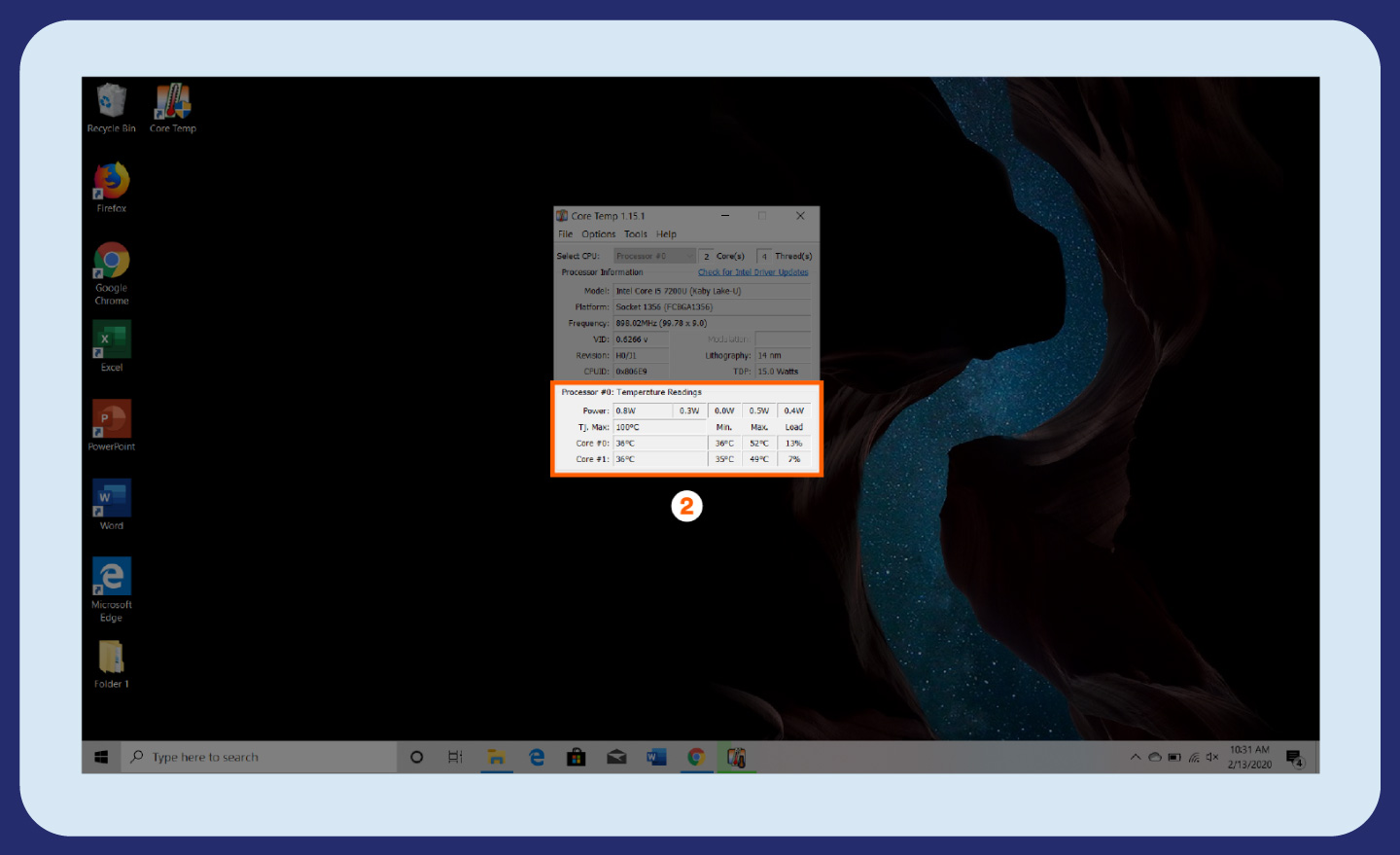
Step 3: Quickly access core temps by selecting show hidden icons at the bottom of your taskbar.
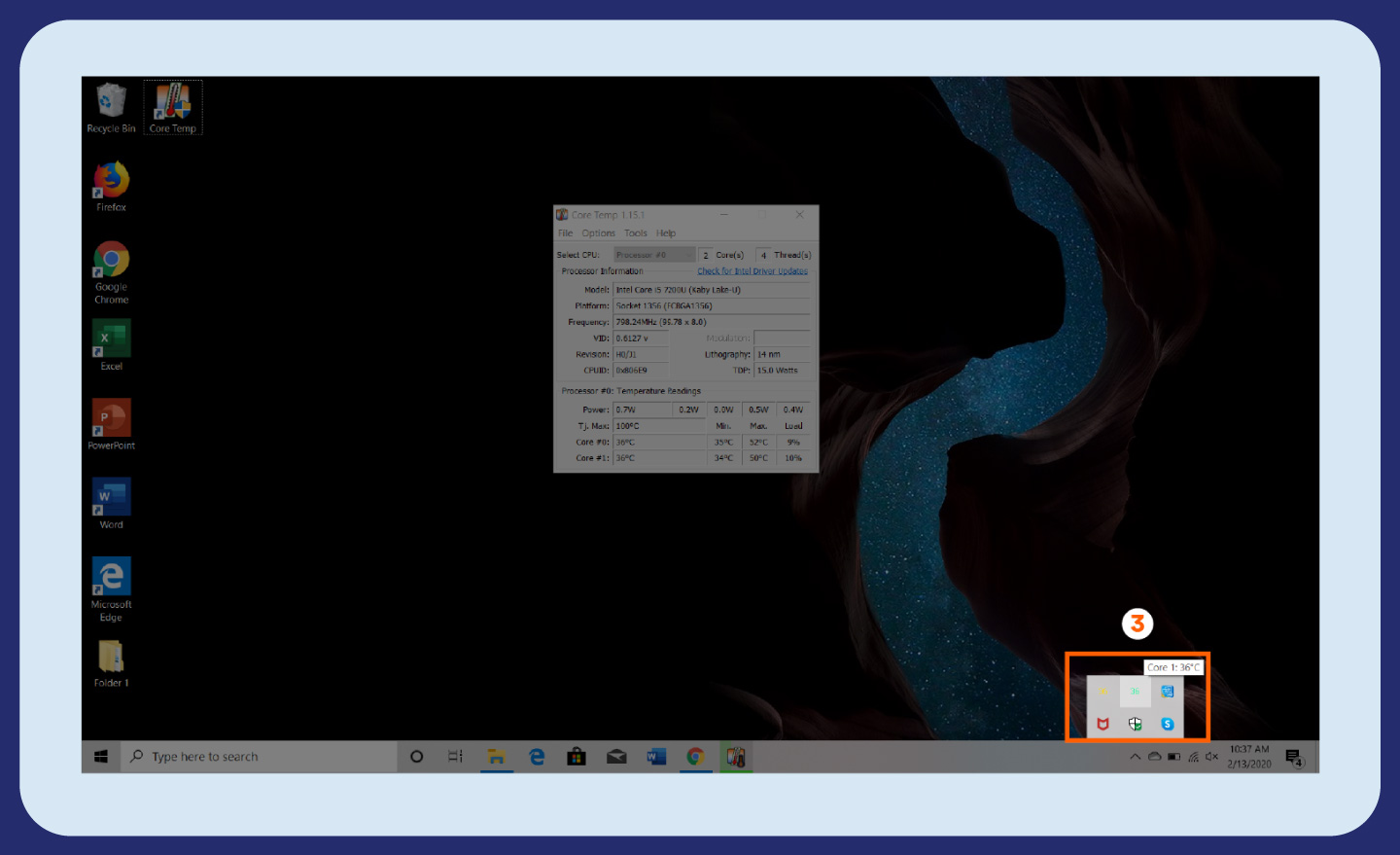
If you are looking for ways to check CPU temp for macOS, the Fanny Widget allows you to monitor your fans and CPU temp right from your menu bar, and SpeedFan allows you to manually control the speeds of your fans.
Aside from Core Temp and the Fanny Widget, a variety of different apps allow you to check and monitor your CPU temps. Some apps are designed for specific device users — like gamers or white hat hackers — but these six apps all offer CPU temperature checks and monitoring.
- HWMonitor: With both free and paid options, HWMonitor is a hardware monitoring system that checks and monitors computer health sensors, including CPU temperature.
- NZXT CAM: NZXT CAM is popular with gamers because it is easy to use, free and can monitor CPU temps during gameplay.
- HWiNFO: Popular with organizations like NASA, HWiNFO is an easy-to-use, free software system that monitors all technical aspects of a technological device.
- Open Hardware Monitor: Designed with temperature in mind, Open Hardware Monitor is open-source software that can monitor CPU temp, fan speed and more.
- Ryzen Master: Built specifically for AMD Ryzen processors, Ryzen Master offers insight into and manual control over CPU temperature, overclocking and more.
- Speccy: Along with PC specs, Speccy gives users an in-depth look into the CPU processor, motherboard and more.
BIOS/UEFI
If you’re unsure about downloading a third-party application or would prefer your system to show you these numbers, Windows has a built-in method to manually check your CPU temperature.
On one hand, you can trust these figures to be accurate, as the information is drawn directly from your computer system. On the other hand, it’s a tedious process. Though not complicated, it requires using the basic input-output system (BIOS) or Unified Extensible Firmware Interface (UEFI) software. These software systems make sure a device’s hardware runs properly.
You can check your CPU temp using the BIOS/UEFI software by rebooting your computer. As your computer restarts, it will give you a designated key — typically F12, F2, ESC or DEL — to access your processor settings.
Step 1: Navigate to the taskbar and select Settings.
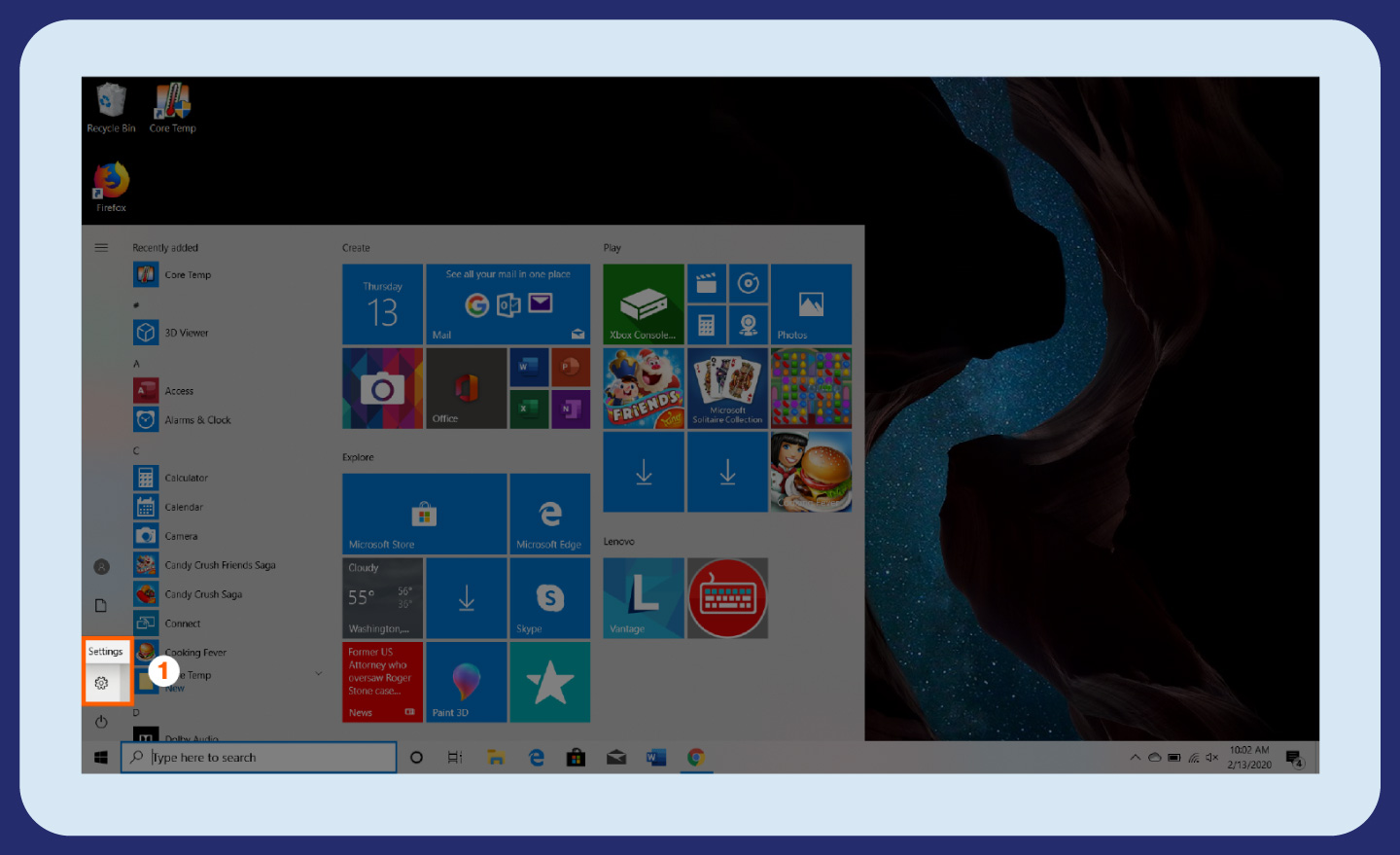
Step 2: Choose Update & Security.
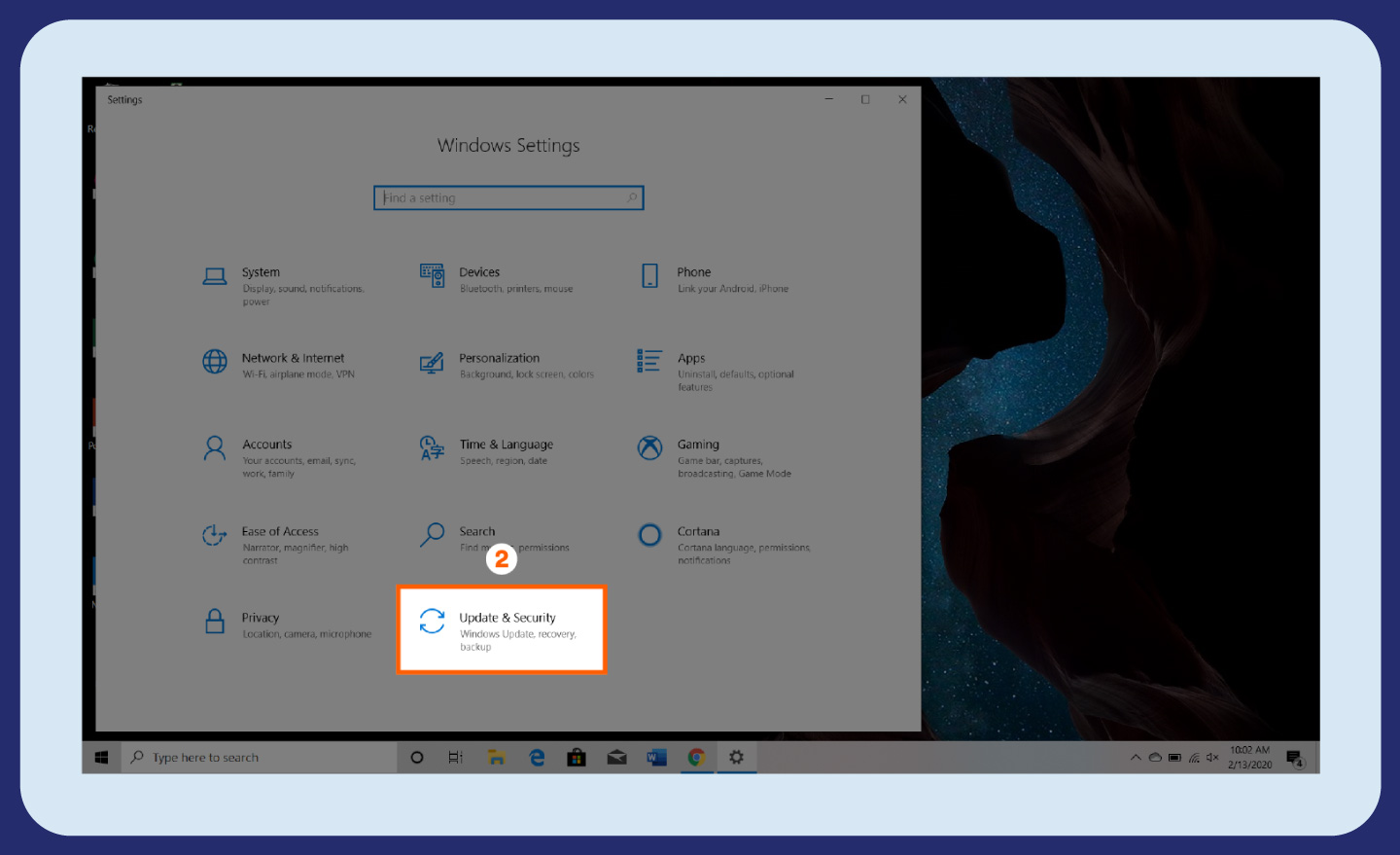
Step 3: On the side panel, select Recovery.
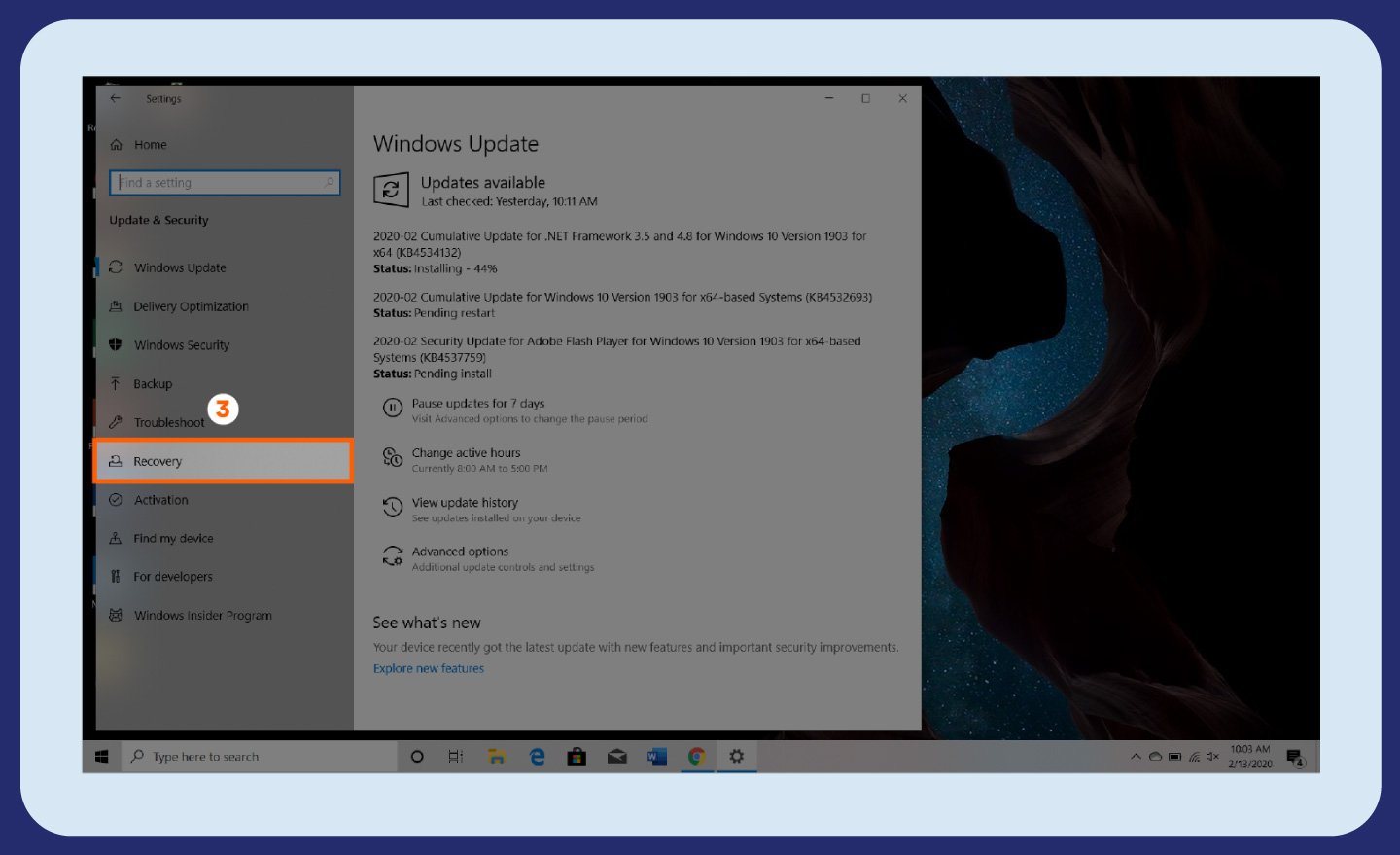
Step 4: Go to Advanced startup and hit Restart now.
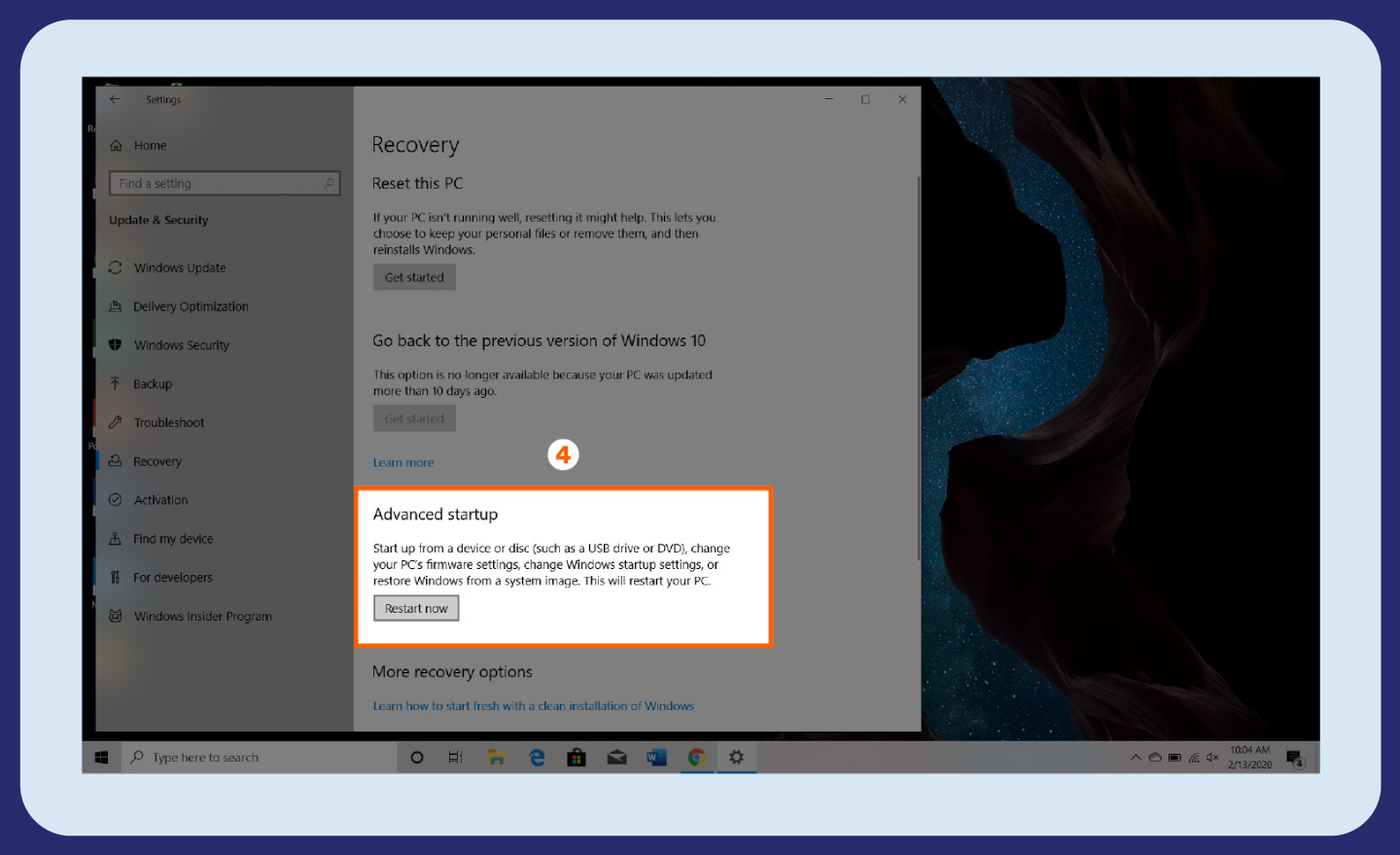
Step 5: On the reboot screen, choose Troubleshoot.
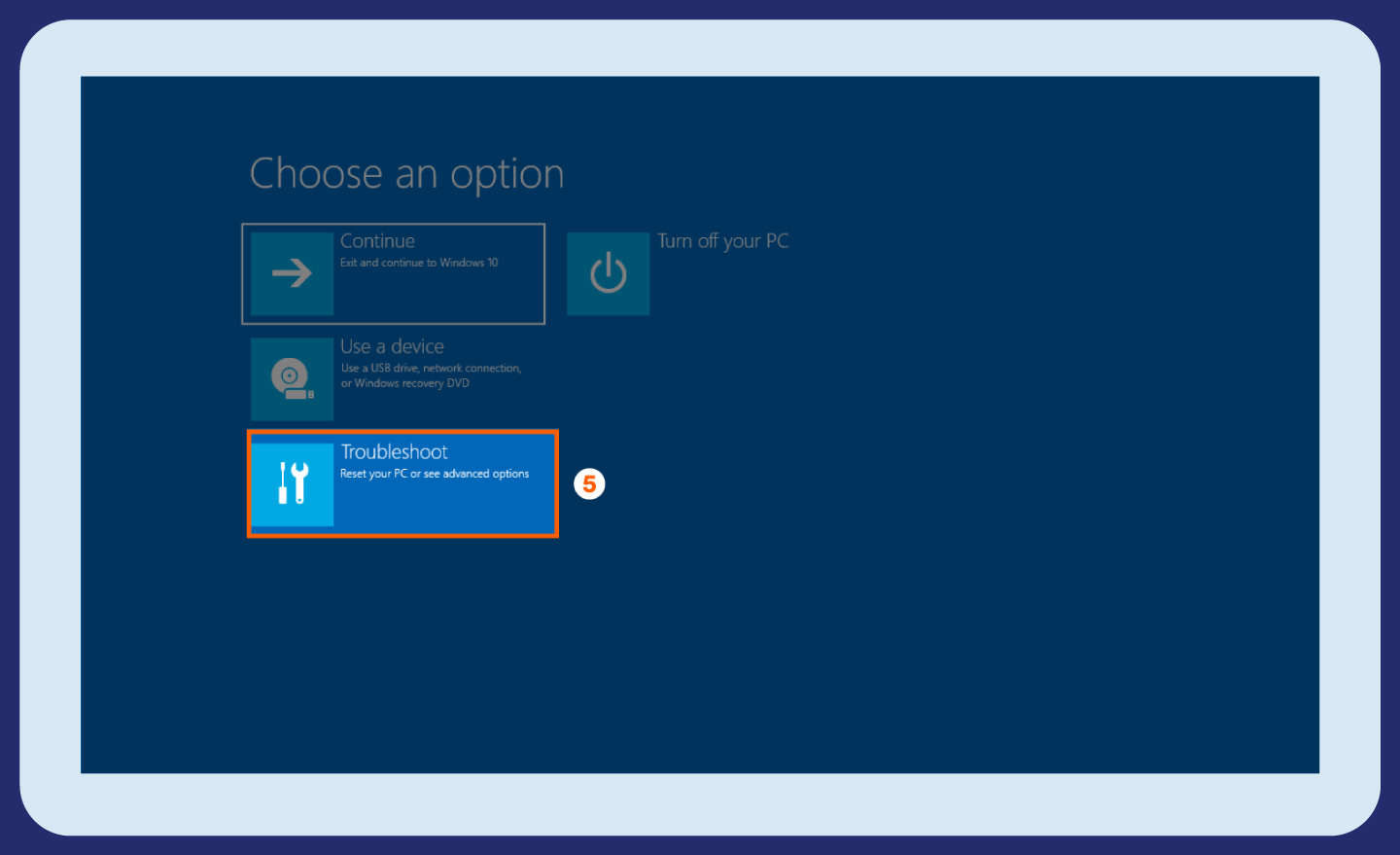
Step 6: Hit Advanced options.

Step 7: Click UEFI Firmware Settings. If your system uses BIOS, skip this step.
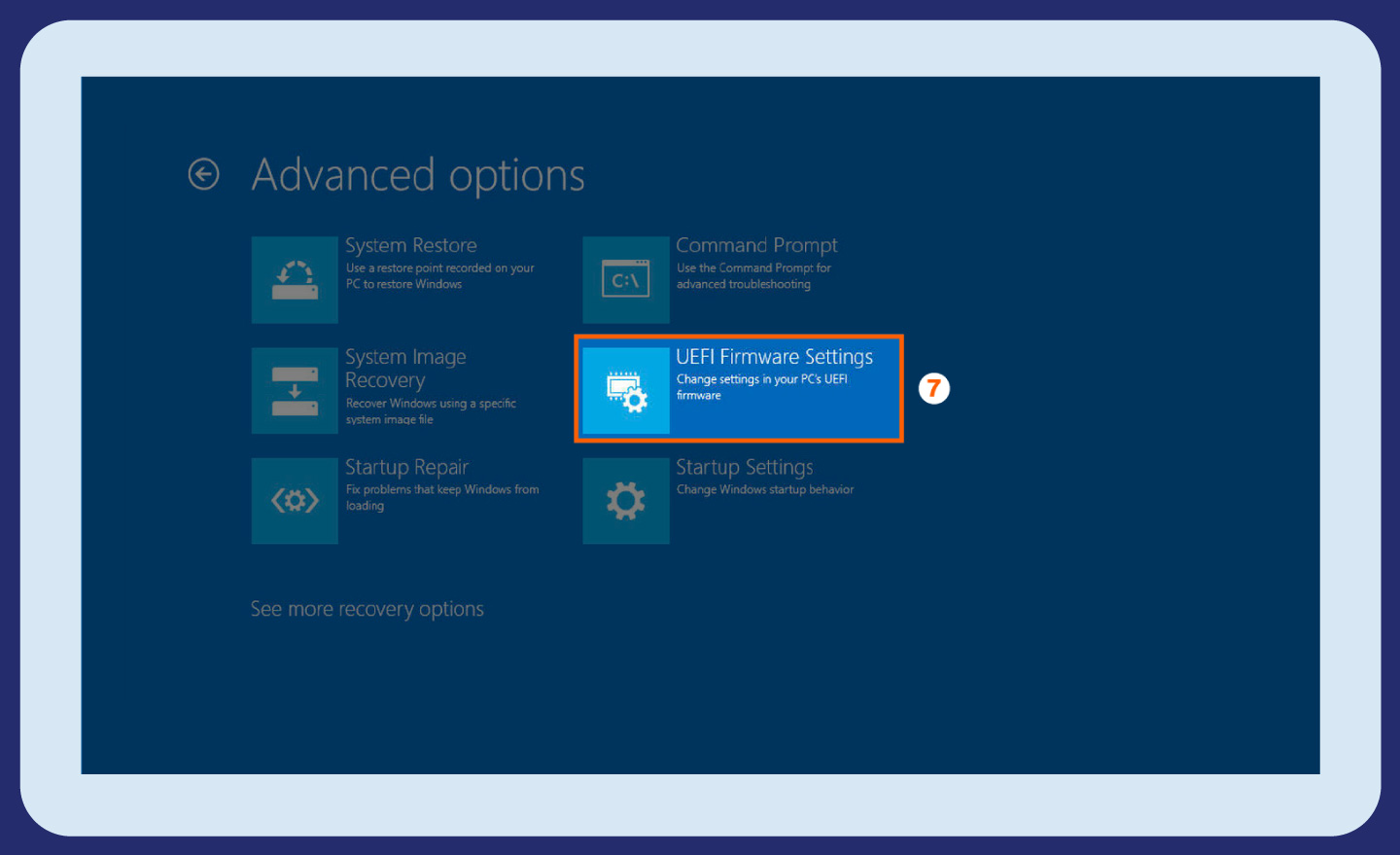
Step 8: Confirm by clicking Restart.
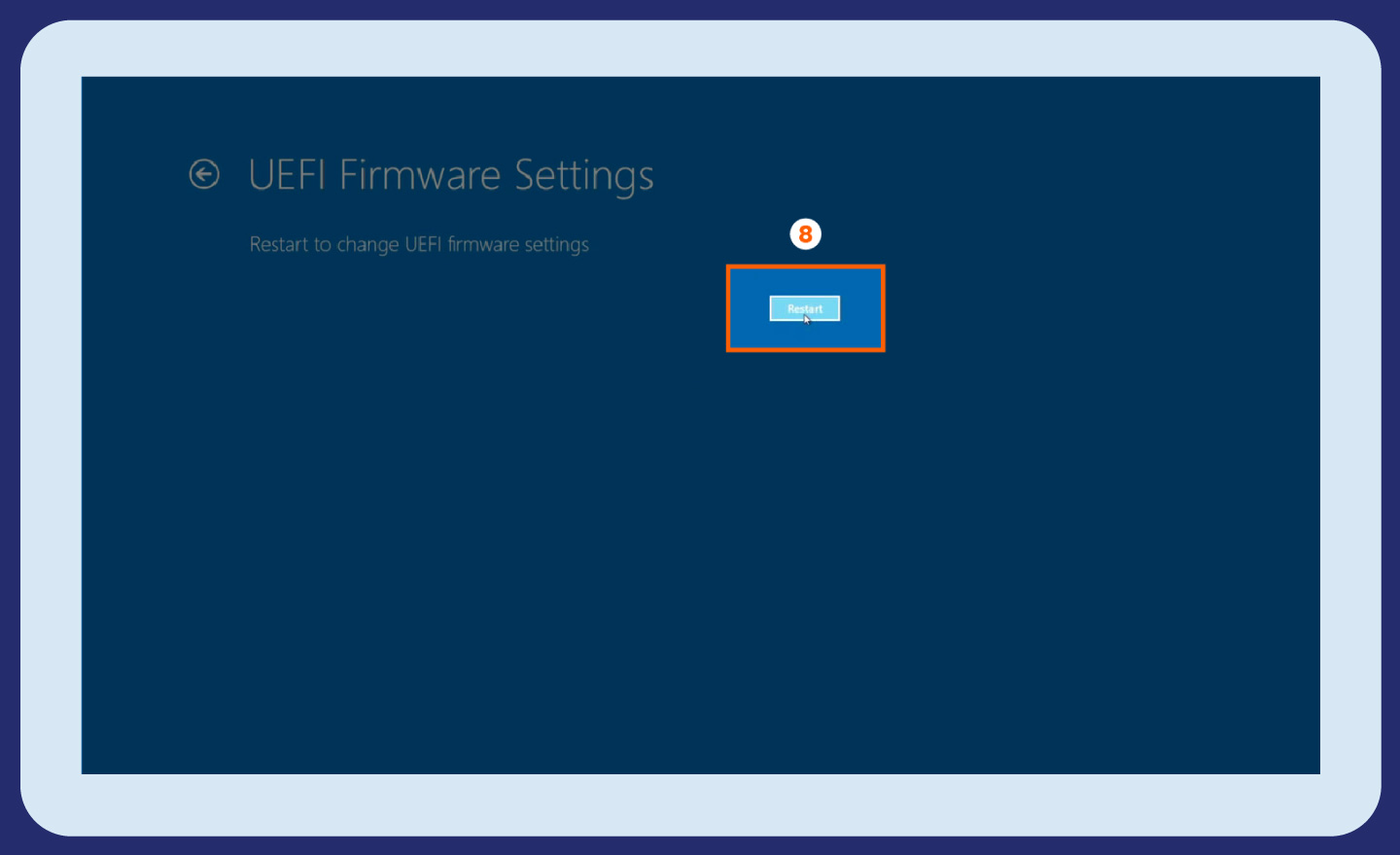
After restarting your system, you will be taken to a screen where your CPU temperature is available. This will be a static temperature, but it should give you an idea of the health of your computer.
What’s the Best CPU Temp for Your Computer?
To keep your computer in the best possible shape, it is ideal to keep your temps under 60°C (140°F). Your computer should be able to perform its best without inflicting damage to your computer if its CPU temps stay around this number.
- Around 60°C (140°F): This is the ideal temperature range for a CPU running smooth and cold.
- 70° to 85°C (158°F to 185°F): This is the normal CPU temperature range for gamers or systems running intense programs.
- 90°C and higher (194°F and higher): This is a dangerous temperature range that can cause irreparable damage to your computer’s components.
Temperatures over 90°C (194°F) can cause serious damage to your computer, especially if they occur regularly and over long periods. If your CPU temperature is consistently high, you may need to replace your device’s fans and revert any overclocking adjustments.
7 Tips for Keeping Your CPU Temp Down
Keeping your computer free from any internal harm and external damage is the best formula for a long-lasting device. Try some of these tips and techniques to keep all of your parts in top shape:
1. Clean Your PC
There are a few ways to keep the inside and outside of your computer clean. You can use a dust rag and a disposable compressed air duster to clean debris from the interior and exterior. You can also open the casing to carefully vacuum around the fans and other hardware components.
Beginners who aren’t familiar with the inner workings of their computers or laptops should have the cleaning process done professionally. This service can help you avoid damaging your computer by accident.
2. Replace Your Thermal Paste
There are times when an overheating issue can easily be solved by removing the old layer of thermal paste and adding a new one. Thermal paste is what transfers the heat from your CPU to the cooler, and when it dries up, your CPU temp can increase. Most thermal pastes will need to be replaced after three years. This should also be done by an expert, as mistakes can damage the component permanently.
3. Purchase a New CPU Cooler
If you are still having trouble cooling down your computer, it might be time for some new fans with a new cooler. Many pre-installed CPU coolers are not able to handle a device’s consistent use, so replacing them can help stop your device from overheating. You can also easily install a water-cooling solution in addition to your fans, or even in place of them.
4. Use a Laptop Stand
An effective way to increase airflow and protect your device is to use a laptop stand. Laptop stands hold your computer at the optimal angle for staying cool. Plus, these hard, flat surfaces allow for air circulation and limit heat build-up.
5. Install Antivirus Software
Without antivirus software, your device is vulnerable to malware. Aside from accessing your personal information, destroying files, or filling your device with spam, malware can overrun your CPU and cause it to overheat. Protecting your devices by downloading antivirus software is the best way to keep your personal information secure.
6. Close Background Applications and Programs
Background applications and programs can be a drain on your computer’s processing power. If you aren’t using a certain application or program, shut it down or install software to put idling programs to sleep. This will allow your processor to focus on the application or program you need to use and lower your CPU temps.
7. Maintain a Cool Environment
Your device is more likely to overheat if your physical environment is too warm. Keeping your PC out of direct sunlight is an easy way to regulate your CPU temp. Additionally, a cool environment will allow your processors to run their best.
If you have a computer that is constantly overheating, it might be time to perform some of these basic checks. Consistently monitoring CPU temps can prevent early retirement of your computer. Unfortunately, if you cannot seem to lower your CPU temp, then it might be time to invest in premium protection services, new parts or even a new computer.
Why Should You Check CPU Temp?
The CPU is responsible for completing the instructions received from the hardware and software. When it overheats, your device could be damaged or destroyed. It’s good practice to periodically check your CPU temp to ensure you aren’t inflicting any unnecessary harm on your device. Monitoring these temperatures can also alert you to other possible problems, like viruses or malicious malware.

Causes of High CPU Temps
If your device is healthy, it shouldn’t overheat randomly. High CPU temps are often caused by some other issue — like having too many programs running or a virus infection. Some of the more frequent causes of an overheated CPU include overclocking, thin computers, old computers, system freezes and slow PCs.
- Overclocking: Your CPU may be overheating because you’re overclocking it. When you overclock a computer, you modify your processor to perform faster than it was originally made for. This can cause your CPU’s temp to increase because it is being forced to work harder than the manufacturer intended.
- Thin Computer: If you own a thin computer, you might notice it gets hot faster than other computers. Many thin computers don’t have enough space to allow for proper cooling technology, including fans. Because thin computers still have the same powerful processors as their predecessors, they can overheat quickly without the proper cooling mechanisms. Owners of these thin computers usually need to buy exterior accessories to cool their computers, like laptop stands or external fans.
- Old Computer: After using your device for many years, there may be dust buildup that stops the fans from cooling the CPU. Disinfecting your computer or replacing its fans can help extend its life. Additionally, antivirus software can protect older computers from dangerous malware or viruses that they are more vulnerable to.
- System Freezes: Sometimes a crash or shutdown has nothing to do with your software or hardware, but it is actually the computer trying to protect itself from long-term damage caused by consistent overheating. To lower this risk, you can free up RAM space by deleting old files and removing unnecessary programs.
- Slow PC: Older computers or those that lack storage space may be forced to run at slower speeds. This can put a strain on your CPU and cause it to overheat. Making your computer faster by tending to hardware or software issues could help keep your CPU temps lower.
CPU Overheating FAQ
An overheating CPU is a common problem many computer users face. As you install more programs over time and the device ages, it’ll have to use more CPU memory and possibly overheat. Here are answers to some commonly asked questions.
What Is CPU Temp?
CPU temp is the temperature of a technological device’s central processing unit. These processors are arguably the most important parts of any device because they process requests and information so the device works properly.
CPU temps can run high if the processor is used over a long period or for multiple high-maintenance tasks. If a CPU’s temperature is too high for too long, the processor can overheat, which could lead to slower processing or system failure. It is important to be aware of the CPU temp to keep a computer running at its best.
Why Is My CPU So Hot?
Several things can cause a hot CPU:
- Demanding activity: Your CPU may be working harder than normal to accommodate multiple applications and demanding tasks.
- Clogged ventilation: It may be that your computer isn’t well ventilated and could use a cleaning.
- Hardware issues: Internal components are malfunctioning.
You need to troubleshoot your PC to understand where the issue is coming from.
How Do I Check CPU Temp in Task Manager?
While you can’t check your CPU temp in your Windows task manager, you can check your CPU performance, speed and uptime. This can also help you pinpoint what’s causing your CPU to overheat.
To check your CPU performance, access your Task Manager, click on the Performance tab and then go to CPU.
The phrase “a well-oiled machine” is worth remembering. For your computer to work properly and for your CPU to function as intended for as long as possible, it’s important to protect your computer from both digital and physical damage. Panda’s Antivirus can help you keep your computer secure from malware and unwanted activity with around-the-clock protection.


